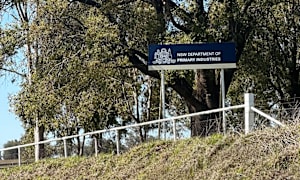Farmers across the Cowra district are being urged to monitor lucerne crops closely after large numbers of cowpea aphids were detected.
These small black sap-sucking insects can damage crops and pose serious risks to livestock health, with younger stock especially vulnerable.
Agronomist Lachlan Graham said the scale of the current outbreak is worse than usual.
“Not in the sort of numbers that we’re talking about this time around,” Mr Graham said.
“They transmit viruses, and there’s even conversation around photosensitisation of stock grazing.”
Latest Stories
“It seems to be going crazy on lucerne.”
Cowpea aphids feed on lucerne, and when animals graze infected plants, toxins can cause photosensitisation, a condition likened to severe sunburn.
Sheep are most affected on unprotected areas such as faces and ears, while white-coated cattle are particularly at risk.
Local vet, Dr Peter Launders explained, saying, “it’s sort of a bit like a really nasty sunburn”.
“With sheep, areas that aren’t covered with wool will get red and sore and crack, and they can get fluid oozing from under the skin.
“In cattle, it’s worse if they’re white, a black and white cow will get photosensitisation on the white bits, but not on the black bits.”
Although few cases have been reported recently, Dr Launders noted that commercial producers usually recognise and treat the problem quickly.
“Producers will know what it is and sort of know how to treat it," he said.
“They don’t necessarily need to call a vet out sometimes."
Treatment involves protecting animals from sun exposure, soothing damaged skin, and preventing further complications.
“Put them in the shearing shed or in shade, totally out of exposure to the sun,” Dr Launders said.
“You can put Vaseline on the cracked skin to give relief and injections for pain are really good as well.
“Prevention is way better than cure, so be aware of what plants can cause it and avoid grazing stock on those.”
He also stressed the importance of feeding affected animals dry fodder.
“Make sure they’re not getting anything green to eat," he said.
“Green plants can worsen the condition of photosensitisation and also affect the liver depending on the toxin."
Aside from the livestock risks, cowpea aphids can also weaken lucerne growth at a time when high-quality feed is needed most.
Lachlan Graham noted that while chemical control options exist, some come with long grazing withhold periods.
“Theoretically, there’s really only chemicals, and some of them have fairly lengthy grazing withholds,” Mr Graham said.
“There are a few softer options as well, but each case would have to be discussed specifically with an agronomist.”
He added that aphid infestations are seasonal and vary between different aphid species.
“Unfortunately, this time around they seem to be worse than normal,” Mr Graham said.
“There’s always been different types of aphids out there, but this year they’ve really got the numbers.
“It’s important that farmers identify what pests they’re dealing with before they react.”
Producers are being encouraged to:
Inspect lucerne crops regularly for aphids clustering on stems and upper leaves.
Monitor stock for symptoms of photosensitisation, especially younger animals.
Seek professional advice from vets or agronomists before choosing a control option.













